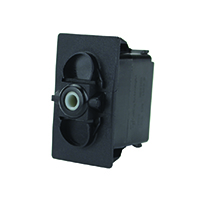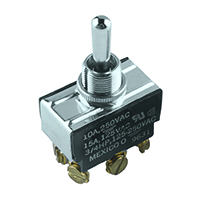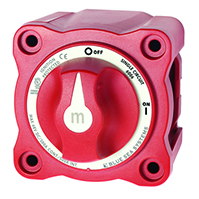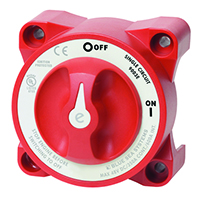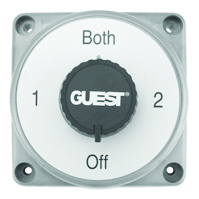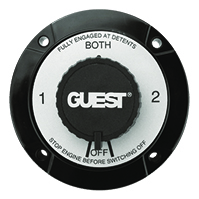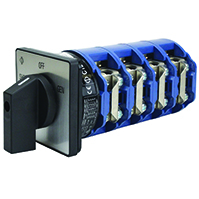The Right Switch for Your Project
Posted by Pacer on 9th Dec 2019

*This Article was published on 12/09/2019 and was updated 1/25/2022*
When it comes to electrical systems, there are a wide variety of components from terminals and connectors to wire management equipment and switches. All those pieces are essential but the ones most taken for granted are likely the switches. Just how much do you know about the switches on your boat? They are one of those things that we just assume will always work. While switches are extremely reliable, it is important to know when to use which type of switch. With so many types out there it can be difficult to know which one is right for your project. Let’s take a look at some of the most common types of switches, but first, let us explain why you need to know the difference and just how important it is.

Knowing the difference between types of switches is both easier and more difficult than you’d think. Let me explain. On the surface, switches can easily be identified by their basic function. You can visually tell if it is a bat toggle switch, battery switch, etc. with just a glance. That’s the easy part. The difficulty arises when you need to know which type of bat toggle or power transfer switch you have. While they look identical on the outside, the internal components are very different. Some may simply be single pole on-off switches while others may be a double pole with momentary action. This is why you need to know, not only which type of switch you are using in general, but what specific part you are using.
"Knowing the difference between types of switches is both easier and more difficult than you'd think."
The importance of knowing which type of switch you are using boils down to safety. Safety for you and your passengers and the longevity of your boat. Using the wrong switch can cause irreparable damage, or even worse, a fire while out on the water. Switches are designed not only to handle a specific function but to handle a pre-determined amperage as well. Using the wrong one can lead to disastrous results. So, now that you know why it is important to be able to tell the difference, let’s look at the most common types of switches you’re likely to run into.

Contura Rocker Switches
Rocker switches are usually added to panels or other surfaces for easy activation of equipment. They come in a wide range of amperage ratings, circuits, colors, illuminations, and print symbols. They are used with switch covers to give a custom appearance to meet the desired look. One factor that contributes to their popularity is the fact that they quickly and easily snap into place and the switch covers used with them snap in just as easily. This cuts down on the time required for installation when compared to other types of switches. All rocker switches offer ingress protection at varying levels and are built for tough environments.
There is a huge number of switches available. It depends on the number of illuminated bulbs you want, if any, as well as the switch action. You can get a single pole or double pole in constant or momentary action. If you look at the chart below, we have done our best to break them out into an easy-to-read format. Simply click on the switch you are interested in to be taken to that page which will have more information for you.
| Part Number | Type of Pole | Switch Positions |
|---|---|---|
| ES-V1DA | Single | ON - OFF |
| ES-V4DA | Single | ON - ON |
| ES-V6DA | Single | ON - OFF - ON |
| ES-V2DA | Single | (ON) - OFF |
| ES-V3DA | Single | ON - (OFF) |
| ES-V5DA | Single | ON - (ON) |
| ES-V8DA | Single | (ON) - OFF - (ON) |
| ES-V7DA | Single | ON - OFF - (ON) |
Bat toggle switches
This type of switch is used when you need a simple power switch on your boat. Bat toggle switches are a simple solution and are known for their easy installation. All Pacer bat toggle switches are rated at 15A/120VAC and carry UL (Underwriters Laboratory), CSA (Canadian Standards Association), and VDE (Verband der Elektrotechnik) approvals making them a solid choice for a marine environment. This is the kind of switch you want for simple on-off situations as well as more complex momentary actions. All bat toggle switches are easy to install and even easier to use. Each bat toggle switch is brass/nickel-plated and built for longevity.
"This is the kind of switch you want for simple on-off situations as well as more complex momentary actions."
Just like the other switches here, bat toggle switches are available with a range of options. The only things you need to decide on are the number of poles and if the action needs to be constant or momentary. Below you will find a chart that lists all the possible configurations for bat toggle switches. Simply click on the switch you are interested in to be taken to the corresponding page which offers more information.
| Part Number | Type of Pole | Switch Positions |
|---|---|---|
| ES-B2FA54 | Single | ON - OFF |
| ES-B2FB54 | Single | ON - ON |
| ES-B2FC54 | Single | ON - OFF - ON |
| ES-B2GE54 | Single | ON - ON - ON |
| ES-B6FA54 | Single | (ON) - OFF |
| ES-B6FA58 | Single | ON - (OFF) |
| ES-B6FB54 | Single | ON - (ON) |
| ES-B6FC54 | Single | (ON) - OFF - (ON) |
| ES-B6FC58 | Single | ON - OFF (ON) |
| ES-B2GK54 | Double | ON - OFF |
| ES-B2GL54 | Double | ON - ON |
| ES-B2GM54 | Double | ON - OFF - ON |
| ES-B6GK5E | Double | (ON) - OFF |
| ES-B6GK5S | Double | ON - (OFF) |
| ES-B6GL5E | Double | ON - (ON) |
| ES-B6GM5S | Double | (ON) - OFF - (ON) |
| ES-B6GM5E | Double | ON - OFF (ON) |
| ES-B6GG54 | Double | (ON) - ON - OFF |
Battery Switches
Few things are as important as safety and that is the main idea behind battery switches. Sure, you can use them to switch between battery banks or even combine battery banks, but their real purpose is fire prevention when doing so. They are so important that the American Boat and Yacht Council (ABYC) require and boat with a battery of over 800 cold-cranking amps to have one of these switches on board. They prevent fires by isolating the battery from the rest of the electrical system. Unlike the other switches we have looked at, battery switches come in several different styles that are visually different for the most part.
Battery switches are available in M-series, E-series, HD series, and Universal series with each series having a particular function or variable that separates it from the other series. Let’s take a look at each of the series and discuss where they are beneficial.
M-series
This type of battery switch is the smallest of all the series as far as power is concerned. The M-series is 300 amp continuous rated for small gasoline engines, small diesel engines, or outboard motors. They offer 300 Amps continuous, 500 Amps (5 mins.) intermittent rating. Additionally, they offer a crank rating of (10 sec.) 1500 Amps and (1 min.) 775 Amps. Below you will see a simple breakdown of the types of M-series we offer. Simply click on the switch you are interested in to be taken to that page.
| Part Number | Circuit Type | Handle Type |
|---|---|---|
| EBS-6005 | Single | Removable Key |
| EBS-6006 | Single | Standard Handle |
E-series
The E-series is the next step up from the M-series. This type of switch offers a 350-amp continuous rating for outboards, small gasoline or diesel engines. They offer 350 Amps continuous, 525 Amps (5 mins.) intermittent rating. Additionally, they offer a crank rating of (10 sec.) 1000 Amps and (1 min.) 750 Amps. Below we have included a chart of the types of E-series that we offer. Just click on the switch you are interested in to be taken to that page.
| Part Number | Circuit Type | Battery Inputs |
|---|---|---|
| EBS-9003E | Single Circuit | 1 |
| EBS-5511E | Dual Circuit Plus | 2 |
| EBS-9001E | 4 Position | 2 |
| EBS-9002E | 4 Position with AFD | 2 |
HD-series
HD stands for “Heavy-Duty” and is the next step up from the E-series. This type of battery switch offers up to 600 amps of continuous power for large diesel engines. They are designed for higher power applications and are built to be tougher than the other styles we have mentioned. We have added a chart below to make switch selection a simple process. Click on the switch you are interested in to be taken to that page.
| Part Number | Style | Positions |
|---|---|---|
| EBS-2303A | Heavy-Duty with AFD | ON - OFF |
| EBS-2304A | Extra Duty with AFD | ON - OFF |
| EBS-2300A | Heavy-Duty Selector | BOTH - 1 - 2 - OFF |
Universal series
The universal series is designed to either switch battery bank 1, or bank 2, or both, to a single load, using one switch or switch a single battery to a single load group depending on which style you are considering. The universal battery switch is built with “make-or-break” technology allowing for the selection of all positions except “off” while the engine is running. Below we have added a chart that covers all the universal switches that we carry. Simply click on the switch you want to be taken to the product page with more information.
| Part Number | Positions | Combine Banks |
|---|---|---|
| EBS-2111 | BOTH - 1 - 2 - OFF | Yes |
| EBS-2112 | ON - OFF | No |
Power transfer switches
This type of switch is the only one on our list that is specifically designed for the boating industry. They are used to connect a boat to shore power. This may not seem like a big deal at first, but it is. Rather than be reliant on generator power, power transfer switches allow you to switch from a generator to shore when shore power is possible. This saves the life of your generator and your overall fuel consumption. Power transfer switches come in a range of options based on the number of poles and the amperage.
When selecting the right power transfer switch for your needs the main things are your specific needs. As stated above, you’ll need to consider the number of poles whether it be 2, 3, or 4 poles, and the amperage. The amperage is available from 10 to 150 to meet a variety of needs. Below you will see a chart that will make selecting the correct power transfer switch a simple task. Simply click on the switch you are interested in to be taken to the product page with the correct switch preloaded.
| Part Number | Number of Poles | Amperage |
|---|---|---|
| EPTS-2P-10A-S00 | 2 | 10 |
| EPTS-2P-20A-S0 | 2 | 20 |
| EPTS-2P-25A-S0 | 2 | 25 |
| EPTS-2P-35A-S1 | 2 | 35 |
| EPTS-2P-50A-S1 | 2 | 50 |
| EPTS-2P-65A-S1 | 2 | 65 |
| EPTS-3P-10A-S00 | 3 | 10 |
| EPTS-3P-15A-S0 | 3 | 15 |
| EPTS-3P-25A-S0 | 3 | 25 |
| EPTS-3P-35A-S1 | 3 | 35 |
| EPTS-3P-50A-S1 | 3 | 50 |
| EPTS-3P-65A-S1 | 3 | 65 |
| EPTS-3P-100A-S2 | 3 | 100 |
| EPTS-3P-150A-S2 | 3 | 150 |
| EPTS-4P-35A-S1 | 4 | 35 |
| EPTS-4P-50A-S1 | 4 | 50 |
| EPTS-4P-65A-S1 | 4 | 65 |
| EPTS-4P-100A-S2 | 4 | 100 |
| EPTS-4P-150A-S2 | 4 | 150 |

So now we’ve had a chance to look at the most common types and switches and discuss their uses, you should have a better understanding of which switch is right for your project. Remember that each switch has a dedicated function that it is designed for and using the wrong switch will never end in a positive way. Need a simple on-off power switch? Use a batt toggle switch. Need to switch from a generator to shore power? Use a power transfer switch. Need to combine battery banks or switch between them? Use a battery switch. Simple questions like these will help you to find the correct switch faster. Just remember that although they may look similar from the outside, each style of switch comes in a range of options with different internal components.
Selecting the correct switch will lead you not only to a safer experience but a more pleasurable one as well as you will avoid a variety of problems. Safety should be your most important concern and the first thing to consider when selecting the correct switch. We understand that choosing the right switch for your project isn’t always an easy task. We have experts with decades of experience ready to answer your questions. Don’t wait. Contact a Pacer Expert today.


